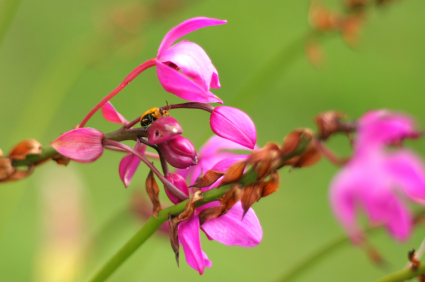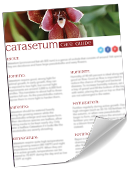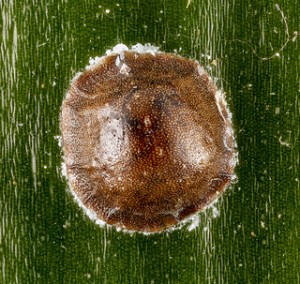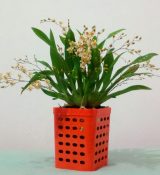Get Rid of Orchid Scale Once and For All
Author: Celeste Booth8 Comments

There are not many pests that can severely damage an orchid collection, but along with mealybugs and aphids, scale is one of orchids’ biggest pests. It is a small insect that can devastate a collection of orchids. A small infestation will result in marred areas on the leaves and large infestation can kill the whole plant. The process to remove them can be complicated but early detection and careful management can prevent the destruction they can cause.
Different Types of Orchid Scale
There are 27 varieties of scale and two main types, soft scale and hard scale. Scale range in size from one to five millimeters and, in certain life stages, can be difficult to see without magnification. Male soft scale appears grayish to white and can look similar to mealybugs. Soft scale damages the plant by sucking sap from the plant. It also leaves behind a sticky excretion called honeydew. Hard scale does not leave this excretion. A large infestation of males will appear powdery and white. Adult females create larger scales that protect eggs. Soft scale can be found along the underside of leaves, along the stem, and even in the roots and rhizomes. Cattelyas are particularly susceptible to a type of brown soft scale called Boisduval scale. Boisduval scale often appears on the undersides of leaves along the midribs and underneath the sheaths. It occurs naturally outdoors in California and Florida, but can appear in greenhouses in any climate. Hard scale is rarer on orchids, but can be identified by its hard brown domes of the adult female.
The Life Cycle
The life cycle of scale is very brief. Scale moves from eggs, to the nymph stage called crawlers, to adults in the matter of a little less than two months, and there may be several generations of scale within a year. These cycles are fastest in an indoor or greenhouse environment. As a result, management, once orchids have been infested, is very difficult. The caretaker must be very persistent in his or her approach and must apply treatment at least every ten days. If you have been using the same treatment for more than a few months and still have scale problems, you must switch treatments as some of the scale may have become immune. The scale is most easily treated during its crawler stage, this is also the stage when it moves between plants. The last stage of the life cycle for a female scale is when it hardens and lays eggs under the protective covering that it is named for. Once the eggs are laid and the shield is hard the scale dies.
Prevention
The easiest way to avoid a scale problem is to stop it before it starts. Scale spreads easiest from plant to plant, and occasionally on air currents. So, it is likely that a scale problem come from a new plant that is introduced to a collection. Be sure to inspect any new plants and even quarantine them for two weeks to see if any evidence of scale appears, because not all stages of scale are visible to the naked eye. If scale does appear, you can treat this plant separately and avoid introducing scale to the whole collection. If you notice scale on a plant you already have, quarantine it right away, while you are treating it, and a short time after to make sure it doesn’t reappear. This should hinder the movement between orchids. Movement will also be stopped between orchids if leaves from different plants are not allowed to touch one another.
If you keep your orchids outdoors, you will also have some assistance from natural predators and parasites. Ladybugs like to eat soft bodied insects and will eat scale. Wasps can also lay eggs inside the hardened scale, they will then feed off the scale eggs and emerge as adult wasps, effectively killing the scale in their first stages of development.
Treatment
For a small infestation, you can rub the scale with isopropyl alcohol on a cotton swab to remove them. This can be hard on the plant, so don’t do it too often or if there a large amount of scale. There is also the possibility of chilling the plant with the fast evaporating alcohol. You may want to wipe away extra alcohol from the leaf so that it doesn’t damage the leaf tissue, especially if the plant is in windy location. If you can, move the plant away from any air currents. Another option for management suggested by the Canadian Orchid Congress, is to carefully wash the whole plant in warm water with grated soap (be sure the soap is mild and not ammonia-based, as this will cause damage to the plant). The plant must be washed every other day for a month. Then it must remain separate from other plants for two weeks to ensure no new scale appears.
The next level in treatment, if the previous two home remedies do not work, is to use horticultural oil. This oil must be applied thoroughly to the orchid. Scale hides well in the sheaths, along the base of the plant, and both the top and bottom of the leaves. It can be easily missed and infest the plant again. The oil works by smothering the scale, so any surface that is not covered will not be effectively treated. The oil can burn the plant’s leaves if used on a hot day or in direct sunlight. Take care to keep the orchid shaded during treatment. Also, take care to follow the directions on the labels very carefully so that you do not damage the plant.

Orchid and Beetle
Finally, if the horticultural oil does not take care of the problem, you may have to use chemicals. Some insecticides are available for use on orchids. Make sure they are labeled for use on ornamental plants, and seek help from a technician if you are unsure if the chemical combination is safe for your orchids. Always follow the label carefully and do not use a concentration any more or less than suggested, too little may be ineffective and too much will kill the plant. Remember that insecticides can be harmful to people and pets. If you cannot spray the orchid outside because of weather, place the plant in a large plastic bag and then spray it. Once the spray has settled, remove the bag and place the plant in an area away from any air currents.
If your plant has had a large infestation you may have scale in the roots. If this is the case, remove the orchid from its container, and shake all of the old growing media loose. You can wash the roots, or if you are using an insecticide, spray the roots. Then repot the plant in a new, clean container with new growing media.
Care tips to remember
Remember, as you care for your orchids, that scale can be devastating and any measures you take as a precaution against it are worth the extra effort.
- Always quarantine new orchids for two weeks before displaying with your collection.
- Check all of the orchids in your collection regularly for signs scale and remove potential problems immediately.
- Keep plants separated and do not allow leaves of different plants to touch one another.
- Once plants have been treated for scale, keep them separated from your collection for two more weeks to ensure the treatment was successful.
If you are battling a scale infestation, be sure to stick with the treatments, repeating them about every ten days. With your persistence and care your orchid collection can be kept scale free and beautiful.
Sources
“Diaspis boisduvalii (Signoret)” Victoria L. Tenbrink, Research Associate, Arnold H. Hara, Entomologist, Beaumont Research Center Hilo, Hawaii http://www.extento.hawaii.edu/kbase/crop/type/d_boisdu.htm
“Boisduval Scale, Diaspis boisduvalii Signoret (Insecta:Hemiptera: Diaspididae)” Adriana Espinosa, Heidi Bowman, Amanda Hodges and Greg Hodges http://edis.ifas.ufl.edu/pdffiles/IN/IN83800.pdf
“Scale Insects on Orchids” Ingrid Schmidt-Ostrander, Canadian Orchid Congress http://www.canadianorchidcongress.ca/Ingrid/scale.html
“Scale Insects on Orchids” Paul J. Johnson, Ph.D., South Dakota State University, http://www.staugorchidsociety.org/PDF/ScaleInsectsonOrchids.pdf
Featured image photo credit: John Tann via https://www.flickr.com/photos/31031835@N08/5231203722/
Scale photo credit: USGS Bee Inventory via https://www.flickr.com/photos/usgsbiml/8349856516/
8 Responses to “Get Rid of Orchid Scale Once and For All”
Leave a Reply


Ask an Expert
Questions about orchids?
Our experts love a challenge!
Photo of the Week
Submit your photo to be featured on the blog!
More Photo of the Week Winners
Submit Photo









I had learned from a man who had such a wonderful varities of orchids that there is hope to kill scale. My mother and him were dear friends. My mother who has been growing orchids for 50 years introduced me to this man who is sinced passed away.
His remedy was to combine in clean large rubber garbage pail 1 bottle 409 cleaning spray and 1 quart alcohol. . Fill the pail up with water. Soak the plants emerging under water for 30 minutes . Scrub leaves back and front removing scale. Resoak.
Let dry and repeatevery 10 days if necessary. Never had aproblem
What size is the large garbage pail?
How large is the rubber garbage pail?
i HAVE INHERITED MY LATE HUSBAND’S ORCHARD COLLECTION SO AM VERY NEW TO CARING FOR THESE BEAUTIFUL PLANTS. i WILL CERTAINLY TRY THE ABOVE. tHANK YOU FOR SHARING.
i’ve drowned the scale by overhead watering infected orchids for a period of an hour or so several times…..integrated pest management
Got sticky substance on my orchid how can I get rid of it
every recommendation says to wash leaves, this seems tedious. I want to skip this and go straight to the hard core chemicals to feed in the soil when watering. What should I use and where can I get them?
I washed the leaves with Dawn dish detergent and warm water. The scale came right off with a little rubbing. Then I raised them well. I think I will do the same for the roots and repot them.